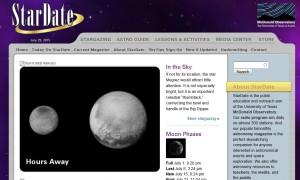Posted by Beth on Thursday, Jul 30, 2015
 This annual celestial event occurs each year in late Summer, with peak viewing near the 2nd week of August. In 2015, the peak will be August 9-13 when up to 60 meteors an hour should be visible in the night sky, especially in the hours between midnight and dawn.
This annual celestial event occurs each year in late Summer, with peak viewing near the 2nd week of August. In 2015, the peak will be August 9-13 when up to 60 meteors an hour should be visible in the night sky, especially in the hours between midnight and dawn.
The Perseid Meteor shower is what we see when the Earth passes through the orbital path of the Swift-Tuttle comet. Swift Tuttle orbits the Sun every 133 years, and each time it gets close to the Sun, small pieces break off and join the cloud of debris in the comet's orbit. Each year when the Earth passes through the Swift-Tuttle's debris field, the debris bounces off the Earth's atmosphere creating the Perseid Meteor Shower.
 The Perseids appear to originate from the top of the constellation Perseus. During August, Perseus will be found in the Northeastern part of the sky, left of the Big Dipper. The point in space where the shower seems to originate is called a "Radiant". The map to the left, from Sky & Telescope, the radiant is shown in yellow text. All the Perseid meteors will appear fly outwards from that point in the sky.
The Perseids appear to originate from the top of the constellation Perseus. During August, Perseus will be found in the Northeastern part of the sky, left of the Big Dipper. The point in space where the shower seems to originate is called a "Radiant". The map to the left, from Sky & Telescope, the radiant is shown in yellow text. All the Perseid meteors will appear fly outwards from that point in the sky.
There are many great Astronomy websites with information about the Perseids.
 University of Texas at Austin McDonald Observatory's web site "StarDate" has a lot of information for people new to star gazing and astronomy. Clicking on the "Stargazing" tab on their homepage will give you a list of the things visible in the night sky this week. This is also where you'll find a link to their Meteor Shower page.
University of Texas at Austin McDonald Observatory's web site "StarDate" has a lot of information for people new to star gazing and astronomy. Clicking on the "Stargazing" tab on their homepage will give you a list of the things visible in the night sky this week. This is also where you'll find a link to their Meteor Shower page.
 The Earth Sky website managed by Deborah Byrd, the host of the long running public radio series EarthSky: A Clear Voice for Science, is a great science web site for non-scientists. The information about the Perseids section of their website is easy to read and has lots of information about the origins of the Perseids as well as how and when to find them and general tips on viewing.
The Earth Sky website managed by Deborah Byrd, the host of the long running public radio series EarthSky: A Clear Voice for Science, is a great science web site for non-scientists. The information about the Perseids section of their website is easy to read and has lots of information about the origins of the Perseids as well as how and when to find them and general tips on viewing.
 To learn more about Comets, Meteors and meteor showers, the NASA website is a great place to start. Plantes, asteroids, meteors, and comets - there are all sorts of neat things at NASA.
To learn more about Comets, Meteors and meteor showers, the NASA website is a great place to start. Plantes, asteroids, meteors, and comets - there are all sorts of neat things at NASA.

There are many other regular meteor showers throughout the year if you can't make the Perseids. Some of the most common can be found on this table, from the University of Texas at Austin McDonald Observatory's StarDate website mentioned above.
Of course, the Iowa City Public Library has lots of material about Astronomy and Stargazing and the staff at any of the public service desks in the Library can help you find more information.


Good introduction to cross stitch for beginners, with lots of easy patterns. The Rosie The Riveter will give you something to shoot for! -Beth